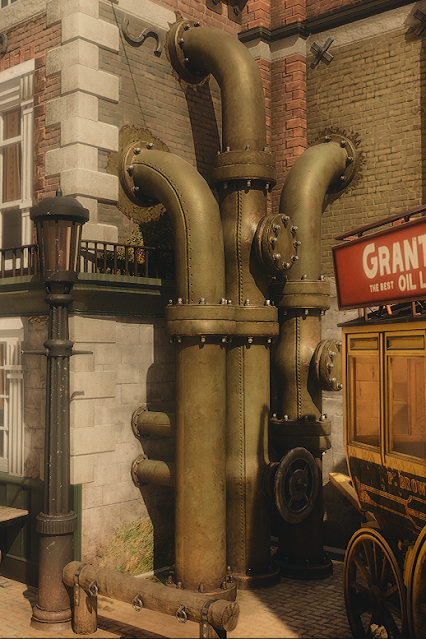This week I had some feedback from my peer Din.
He gave me some recommendations for my scene, which I carried out.
One of the recommendations was to put some dirt buildup around the edge of this building as it looked a bit too plain.
Another recommendation he told me was to change the pipes a bit for variety - he initially told me to potentially rotate the bolted seam, but knowing this would have to be done in substance painter again, I opted for the easier option which was to create a material instance with a flatten normal node, I then put this on to varying pipes to break up the seams.
Though dyes were becoming more common as the British Empire expanded, he recommended I change the colours of the tiddlywinks, because plastics and plastic dyes were more expensive to make, especially ultramarine and purple dyes as traditionally blue dyes were made from lapis lazuli or Azurite.
- 'The earliest known blue dyes were made from plants – woad in Europe, indigo in Asia and Africa, while blue pigments were made from minerals, usually either lapis lazuli or azurite, and required more. Blue glazes posed still another challenge since the early blue dyes and pigments were not thermally robust.' -https://books.google.co.uk/books?id=P_Ixuott4doC&redir_esc=y
' Tyrian purple dye was so costly because it was difficult to make. The source of the dye was the mucus produced by predatory sea snails found in the Mediterranean Sea.' - https://exhibitions.kelsey.lsa.umich.edu/ancient-color/purple.php#:~:text=Tyrian%20purple%20dye%20was%20so,found%20in%20the%20Mediterranean%20Sea.
He told me to revise the glasses, in references I found the glasses were more 'foggy' as victorian glass didn't use modern glass blowing technology, resulting in some defects in the glass. Furthermore, it was mentioned that the glass needed thickness, because the glass was touching the table before, it was recommended I add an extra bit to the bottom of the glass to make it look a bit more 'glass like'. I put the top bit of the glass and the newly added bottom part to different material IDs so I could control the glass to look different for both parts.
One of the things that was pointed out to me that I didn't initially notice was the floors being too low/windows were too large.
Whereas in the newer screenshot, you can see that the windows have gotten smaller - I used anchour plates on the side of the building, not only for decoration to fill out space, but to give the idea of structural integrity (for people that understand what anchour plates are used for).
the main problem I encountered was the leveling of the walls and ceilings, they were all too close together and when I put a measuring tool next to the window in 3ds max, I saw that the windows were almost as tall as my measuring tool (for reference I use 180cm as an average height for a 5'11'' person).
So the first thing I needed to do was rescale them.
Although the windows looked fine in a stylistic sense, these windows are more realistic to the actual size of windows, but also don't detract much from the areas that have been changed.






No comments:
Post a Comment